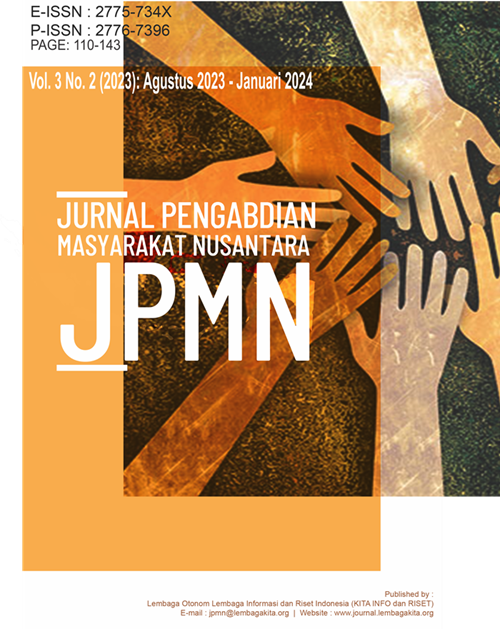Published: 2023-12-13
Peningkatan Kompetensi TPACK Guru Melalui Pelatihan Pengembangan Media Pembelajaran Berbasis Augmented Reality
DOI: 10.35870/jpmn.v3i2.1856
Basith Rahmatullah, Irma Kadarwati
Article Metrics
- Views 0
- Downloads 0
- Scopus Citations
- Google Scholar
- Crossref Citations
- Semantic Scholar
- DataCite Metrics
-
If the link doesn't work, copy the DOI or article title for manual search (API Maintenance).
Abstract
The aim of this research is to assess the effectiveness of an Augmented Reality-based instructional media development training model in enhancing teachers' competencies to develop and utilize Augmented Reality-based instructional media. The 4D research and development model consist of four stages: define, design, develop, and disseminate. The current situation presents an opportunity for teachers to optimize the presence of smartphone technology and mobile devices by integrating traditional methods with technological approaches in education. The integration of smartphones or mobile devices with traditional teaching aids such as print media (books, posters, etc.) brings about innovations in instructional media, known as Augmented Reality. To implement and enhance Augmented Reality-based instructional media, teachers need knowledge in planning and developing such media to create engaging digital-based learning experiences. Data analysis in this developmental research is conducted pre-training, during training, and post-training. Assessing the improvement in participants' learning outcomes requires initial and final test data. The initial test scores yielded an average of 58.7, while the final test scores showed an average of 81.8, indicating a 39% increase in test scores. Encouraging active involvement of teachers in professional development programs or competency enhancement training is crucial in advancing the use of technology in education.
Keywords
Augmented Reality ; Learning media ; Training Development
Article Metadata
Peer Review Process
This article has undergone a double-blind peer review process to ensure quality and impartiality.
Indexing Information
Discover where this journal is indexed at our indexing page to understand its reach and credibility.
Open Science Badges
This journal supports transparency in research and encourages authors to meet criteria for Open Science Badges by sharing data, materials, or preregistered studies.
How to Cite
Article Information
This article has been peer-reviewed and published in the Jurnal Pengabdian Masyarakat Nusantara (JPMN). The content is available under the terms of the Creative Commons Attribution 4.0 International License.
-
Issue: Vol. 3 No. 2 (2023)
-
Section: Articles
-
Published: %750 %e, %2023
-
License: CC BY 4.0
-
Copyright: © 2023 Authors
-
DOI: 10.35870/jpmn.v3i2.1856
AI Research Hub
This article is indexed and available through various AI-powered research tools and citation platforms. Our AI Research Hub ensures that scholarly work is discoverable, accessible, and easily integrated into the global research ecosystem. By leveraging artificial intelligence for indexing, recommendation, and citation analysis, we enhance the visibility and impact of published research.




-
Rahmayani, I. (2015, 10 2). Kominfo. Diambil kembali dari Kominfo: https://kominfo.go.id/content/detail/6095/indonesia-raksasa-teknologi-digital-asia/0/sorotan_media
-
Georgiev, T. (2015). M-Learning-A New Stage of E-Learning. Diambil kembali dari International Conference on Computer System and Technologies (Online): http://ecet.ecs.uniruse.bg/cst04/Docs/sIV/428.pdf
-
-
-
-
-
-
-
-
-
-
-
-

This work is licensed under a Creative Commons Attribution-NonCommercial-NoDerivatives 4.0 International License.
Authors who publish with this journal agree to the following terms:
1. Copyright Retention and Open Access License
Authors retain copyright of their work and grant the journal non-exclusive right of first publication under the Creative Commons Attribution 4.0 International License (CC BY 4.0).
This license allows unrestricted use, distribution, and reproduction in any medium, provided the original work is properly cited.
2. Rights Granted Under CC BY 4.0
Under this license, readers are free to:
- Share — copy and redistribute the material in any medium or format
- Adapt — remix, transform, and build upon the material for any purpose, including commercial use
- No additional restrictions — the licensor cannot revoke these freedoms as long as license terms are followed
3. Attribution Requirements
All uses must include:
- Proper citation of the original work
- Link to the Creative Commons license
- Indication if changes were made to the original work
- No suggestion that the licensor endorses the user or their use
4. Additional Distribution Rights
Authors may:
- Deposit the published version in institutional repositories
- Share through academic social networks
- Include in books, monographs, or other publications
- Post on personal or institutional websites
Requirement: All additional distributions must maintain the CC BY 4.0 license and proper attribution.
5. Self-Archiving and Pre-Print Sharing
Authors are encouraged to:
- Share pre-prints and post-prints online
- Deposit in subject-specific repositories (e.g., arXiv, bioRxiv)
- Engage in scholarly communication throughout the publication process
6. Open Access Commitment
This journal provides immediate open access to all content, supporting the global exchange of knowledge without financial, legal, or technical barriers.
